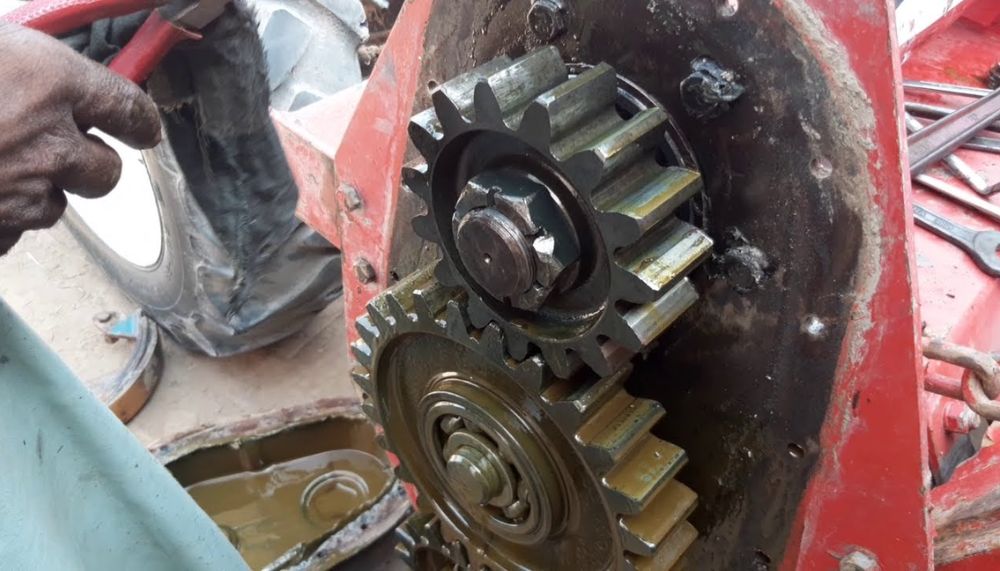Chat With Us
+91 99253 37969Troubleshooting Rotary Tiller: Typical Problems and Fixes

A rotary tiller, also known as a rotavator, is an effective tool for preparing fields for planting by breaking up soil. However, like any other equipment, rotary tiller can develop issues over time.
You may save time, reduce downtime, and avoid expensive maintenance by learning how to diagnose common problems. This comprehensive guide will help you comprehend and expedite the least amount of typical rotary tiller problems.
Common Rotary Tiller Problems and How to Fix Them
1. The Engine Won't Start
One of the most annoying problems is the rotary tiller's engine not starting. Problems with ignition or fuel are frequently the source of this inconvenience.
Reasons:
- The fuel strains may become clogged due to an empty tank or old or contaminated gasoline.
- A blocked fuel filter may restrict the flow of fuel to the engine.
- If the spark plug is worn out or clogged, it may not ignite.
- A weak or dead battery may cause rotary tillers with electric starters.
Solution:
- Make sure there is clean fuel in the gas tank.
- If the fuel filter is blocked, check it, smooth it out, or replace it.
2. Engine Starts But Loses Power
If the engine starts but then loses power, it may indicate issues with the exhaust system, gas shipping, or air consumption.
Reasons:
- The engine may struggle if a clogged air filter restricts airflow.
- Power outages can result from clogged fuel pipes, which reduce gasoline flow.
- Overheating and a loss of strength may arise from a clogged exhaust.
Solution:
- To improve airflow, clean or replace the air filter.
- Check for obstructions in gas lines and clean them as necessary.
- Look for obstructions in the exhaust and clear it.
3. Rotary Tiller Blades Not Rotating
The power mechanism is usually the cause of the rotary tiller blades' inability to revolve.
Reasons:
- Power cannot reach the blades if the force belt or chain is worn out or broken.
- It's likely that the engagement lever is stuck or isn't properly engaging the blades anymore.
- The blades will no longer revolve effectively if they are not firmly fastened.
Answers:
- If the strength belt or chain is worn out or damaged, check it and replace it.
- Verify that the engagement lever is operating correctly.
- Any loose or damaged blades should be tightened or replaced.
4. Noise and Vibrations That are Too Loud
Your rotary tiller may have a mechanical issue that needs immediate repair if it is shaking excessively or producing strange noises.
Reasons:
- Insecurely attached parts may cause noise and vibrations.
- Grinding sounds and vibrations can be produced by worn bearings.
- Excessive vibration may result from damaged or bent blades.
Answers:
- To reduce vibrations, tighten any loose nuts or screws.
- Examine the bearings and swap them out if necessary.
- Any bent or broken blades should be replaced.
5. Rotary Tiller Excavates Too Deep or Not Deep Enough
An incorrect depth can reduce the efficiency of tilling, and the rotary tiller's intensity can impact soil.
Reasons:
- Depending on the kind of soil, the depth may be either too shallow or too deep.
- The intensity of tilling may be impacted by worn tines' inability to dig as well.
- The rotary tiller's digging depth may be impacted by hard, dry soil or extremely moist soil.
Answers:
- To maintain healthy soil conditions, change the intensity settings.
- Examine the tines and replace any worn ones.
- Avoid operating the rotary tiller in extremely dry or rainy conditions as this might affect its functionality.
6. Engine Overheating
If overheating is not immediately managed, it can seriously harm the engine.
Reasons:
- The engine may overheat if the air filter is blocked.
- The engine may overheat if the cooling fins, which help to burn up heat, are obstructed by dust.
- Low oil levels increase heat and friction by decreasing lubrication.
Answers:
- To avoid overheating, clean or replace the air filter regularly.
- Examine and clear the cooling fins of any debris or dirt.
- As certain the oil's exact level and swap it following the manufacturer's recommendations.
7. Uneven Tilling Outcomes
If the rotary tiller is leaving behind areas of untitled dirt, it may not be operating as well as it should.
Reasons:
- Uneven results may result from worn or broken tines.
- An unbalanced or choppy rotary tiller may dig unpredictably.
- Tilling results become choppy if you move too quickly.
Answers:
- To ensure steady tilling, replace broken or worn tines.
- Verify that the rotary tiller is balanced and level.
- Reduce your speed to let the blades to operate effectively on each skip.
8. Clogging of Soil within the Rotary Tiller
Clogging of the soil can generate an uneven tilling pattern and gradually slows down the rotary tiller.
Reasons:
- Rotary tiller blades can without difficulty emerge as clogged by means of wet soil.
- Certain blade designs are not suitable for positive soil kinds, which would possibly cause blockages.
Answers:
- Prior to tilling, allow the soil to dry out.
- To reduce clogging, choose tines or blades which are more appropriate for your type of soil.
In conclusion
Your rotary tiller can continue to operate at its peak efficiency and deliver reliable, effective soil preparation with routine troubleshooting and preventative maintenance. You can prolong the life of your rotary tiller, lower the number of breaks, and enjoy trouble-free, seamless operation with the proper maintenance and prompt repairs.
You May Also Like:







